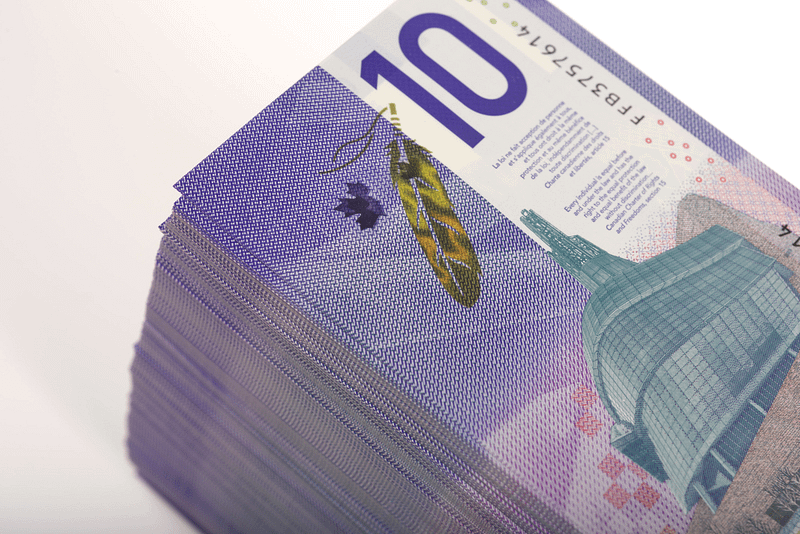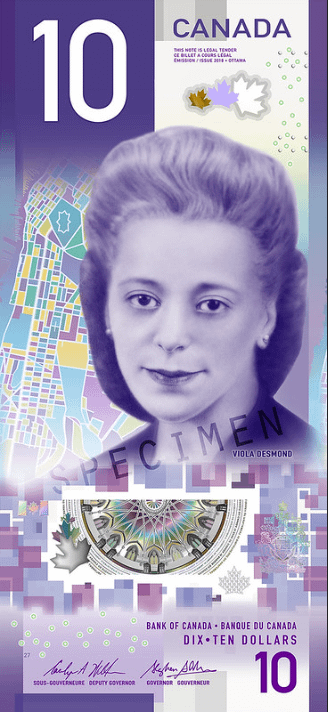6 Things To Know About Canadian $10 Bills

The Canadian $10 bill is the second most-circulated denomination of currency in circulation. The banknote has gone through several designs since its debut in 1935.
In 1983, a new series was issued under Queen Elizabeth II that featured images of National parks from across Canada, including Niagara Falls and Pacific Rim National Park Reserve (now called Pacific Rim National Park). This design changed to feature images related to Canada’s cultural heritage eight years later when Minister Monique Landry unveiled a smaller version of the same issue.
A total redesign took place in 2001 with production quality improvements. This series notes also were slightly larger than those preceding them. In 2006, a revision was made featuring Prime Ministers Wilfrid Laurier on one side and John A. Macdonald on the other side – these are still used today during actual transactions by Canadians everywhere.
In 2018, the Canadian $10 bill was redesigned to commemorate the 100th anniversary of women’s suffrage in Canada. The new design features a portrait of Viola Desmond on the front and an image showing people gathering for a rally for voting rights for women on the back. Other security measures such as raised ink printing techniques, colour-shifting numbers and textured design elements were added to make it more difficult to counterfeit these notes.
What Do The Pictures On The Canadian $10 Bill Mean?

Viola Desmond Is The Portrait On The Front Of The Canadian $10 Bill
Viola Desmond was a Canadian civil rights pioneer who made history in 1946 when she challenged racial segregation at a movie theater in Nova Scotia. Described by some as Canada’s “Rosa Parks,” Desmond broke the law when she refused to move from her seat on the main floor of a whites-only section of the Roseland Theatre.
She was sentenced to 30 days in jail and fined for violating local segregation laws. This sparked protests throughout Nova Scotia and inspiring future generations of Canadians interested in fighting racism and oppression.
Viola Desmond was born on July 6, 1914 to a black Nova Scotia family and helped manage her father’s Halifax beauty academy. She earned a beautician certificate from the Field Beauty Culture School in Montreal. In 1938, Desmond moved back to Halifax where she began selling cosmetics. Her products were distributed throughout Atlantic Canada, allowing her business to blossom into “Viola Desmond Cosmetics”—the largest of its kind in the region at that time.
In 2010, Desmond posthumously received an official pardon from Governor General Michaëlle Jean—the first such pardon issued since Confederation (Canadian independence). Desmond left an indelible legacy for generations of Canadians interested in fighting racism and oppression.
The Metallic Shape On The Front And Back Is The Library of Parliament
The Canadian Library of Parliament is the main library of the Government of Canada and provides research services to Members of Parliament, their staff and Senate members. It collects, preserves and makes available for study a comprehensive collection on all aspects of government operations in both official languages.
The Library also produces online reference tools such as quick facts sheets, briefing notes, guides to parliamentary proceedings and public information products designed to enhance Canadians’ understanding of democracy in action.
It is a non-circulating library, meaning it does not loan out books or other materials. Its collection includes more than 600,000 documents in various formats and covers topics such as taxation, international law, public works and services, the environment, health care policy and science & technology.
In addition to its research resources for parliamentarians and members of their staffs-it also serves as Canada’s official depository for government publications from both federal government departments/agencies as well provincial legislative bodies.
The Map On The Front Is The Historic North-End Of Halifax
The Historic North End of Halifax is a vibrant and culturally rich neighbourhood in the centre of Canada’s Atlantic Coast. It was Viola Desmond’s neighborhood. It is home to some of the city’s oldest buildings, dating back to when it was first established in 1749 as part of British Colonialism and has since developed into one of Halifax’s most diverse neighbourhoods with many historically significant sites.
The area also boasts a variety of restaurants, independent shops, galleries and entertainment venues making it an exciting destination for both locals and visitors alike.
The Historic North End of Halifax has a unique character and history that makes it one of the oldest and most historic neighbourhoods in Canada. It is home to numerous cultural institutions, festivals, museums as well as other attractions for visitors to explore such as Citadel Hill national historic site or Point Pleasant Park – a large park overlooking the harbour with scenic trails and incredible views.
With its laid back vibe, captivating stories from locals, annual outdoor events like Busker Festival and Italian Week Festival plus some delicious eats — there is never a dull moment around this part of town!
The Building On The Back Is The Canadian Museum for Human Rights
The Canadian Museum for Human Rights (CMHR) is a national museum located in Winnipeg, Manitoba. It celebrates of human rights achievements and struggles throughout history, with an emphasis on Canada’s role throughout the world. CMHR features permanent and temporary exhibits featuring topics from Indigenous Peoples’ rights to global citizenship and peaceful conflict resolution. Educational programming hosted by the museum covers a wide range of topics related to human rights from immigration stories to art projects that express empathy towards those struggling with injustice or inequality around the world.
The CMHR also has a mission to act as an instrument of change in the promotion of human rights understanding and respect. Through its public programs, outreach initiatives, and digital media projects, it is doing just that. It is working with individuals from all backgrounds to foster meaningful conversations about human rights topics.
The CMHR is the first museum of its kind in North America. Activists and scholars alike have praised it for its ability to integrate global perspectives into Canadian human rights education, creating a space where all can explore and appreciate their country’s history from an informed perspective – one that emphasizes respect and understanding.
The Eagle Feather On The Back Represents First Nations
An eagle feather is a powerful symbol and source of spiritual energy for First Nations in Canada. It represents trust, honour, power, strength and wisdom. The feathers are traditionally used by Indigenous people as part of their ceremonies or rituals and passed down through generations as keepsakes to remind them of the importance of family values, respect for nature, protection from harm and personal responsibility.
The eagle feather also serves as a tangible reminder of the teachings and values of Indigenous spirituality. It is believed that holding an eagle feather helps to bring clarity, insight, guidance and healing.
What Are The Security Features Of The $10 Canadian Bill?
Advanced Security Features
The $10 Canadian bill features advanced security features to help ensure its authenticity. These include a transparent window with detailed holographic images. You can also feel raised ink and other unique tactile elements by running a fingertip across the note’s surface.
Unique Serial Numbers
Each individual currency is assigned a unique serial number etched in black lettering on the face side of the banknote. This give it additional protection against counterfeiting and forgery attempts.
Intaglio Printing Technology
Special intaglio printing technology gives each $10 Canadian bill an unmistakable feel of quality when touched or held up to light. This is adding further assurance that it is real currency from Canada’s Bank of Canada Federal Reserve notes program.
Watermark Portrait
A watermark portrait can be seen when the bill is held up to light. The number “10” appears next to it as an added security feature.
Who Signs The Canadian $10 Bank Note?
The Canadian $10 Bill is signed by the same people who sign the Canadian $20 bill. They are the governors of the Bank of Canada.
Right signature: Tiff Macklem
Tiff Macklem became the Governor of the Bank of Canada in July 2020. He has a long and distinguished career in public service, both at the federal and provincial levels. Prior to his appointment as Governor, he served as Senior Deputy Governor – the Bank’s second-highest ranking position – from 2014 to 2020.
Macklem has a PhD in economics from the University of Toronto. He has been a faculty member at both the Rotman School of Management and Western University’s Ivey Business School. He has also held senior positions in the Canadian government, including as Clerk of the Privy Council (the federal government’s top civil servant), Deputy Minister of Finance, and Associate Deputy Minister of Industry.
Left signature: Carolyn Rogers
Carolyn Rogers is the current Deputy Governor of the Bank of Canada and a member of its Board of Directors. She has held this role since 2021, joining from Canadian Imperial Bank of Commerce where she was Senior Executive Vice-President for technology and operations. Prior to her roles at CIBC, Rogers spent 19 years in total with the central bank. 17 of them were as Chief Risk Officer. The two leading up to that were as Manager/ Head Risks & Controls Group Financial Markets Department. During her tenure at BOC Carolyn championed changes to modernize internal infrastructure. She strengthened the financial system stability oversight – through data analytics initiatives, artificial intelligence capabilities within banking supervision activities
In addition to her roles in the financial industry, Carolyn serves as an External Member of the Takeover Panel and is a Director on the Board of Pollard Banknote. She holds undergraduate degrees from both Dalhousie University (BSc Computer Science) and McGill University (BA Economics).
What Are The Serial Numbers On A Canadian $10?
Serial numbers on Canadian bank notes are used to identify and track each note as they enter into circulation. This makes it easier for financial institutions like banks or payment processors to authenticate the currency. Serial numbers can also help with accounting purposes, tracking deposits and withdrawals of cash from an institution’s records. Additionally, having unique serial numbers makes counterfeiting more difficult by allowing law enforcement agencies to trace any suspected counterfeit bills back to their source.
What To Do If I Find $10 Bills?
If you find $10 bills, the best thing to do is spend it! Think about something that you need or want and invest your newfound money into it. If there isn’t anything you need right away, consider putting the funds in your savings account for a rainy day. Don’t forget about taxes! Depending on how many $10 bills you’ve discovered, there may be legal obligations associated with finding large amounts of cash. Always consult an attorney first if you find very large sums of money.
How To Get A Canadian $10 Bank Note?
The best way to get a Canadian $10 bill is to withdraw at a bank, or ATM. Not all of them handle smaller denominations than $20 Canadian dollars though. For Canadians, this is very easy. It is also possible to receive a Canadian $10 bill when making purchases with retailers which give you more than $10 in change. If you are abroad, you get them by exchanging your local currency at an exchange office. You may also be able to find someone willing to exchange their own currencies for the desired amount of money on platforms such as Craigslist or Facebook Marketplace.
